Why you can trust TechRadar
We spend hours testing every product or service we review, so you can be sure you’re buying the best. Find out more about how we test.
Founded in 2020, UK-based SOAX is one of the youngest of the big proxy service providers, but don’t let that put you off. The company has been working exceptionally hard to grow its service, and now offers a 191m+ pool of ethically-sourced proxies in residential, mobile, USA ISP and datacenter forms.
It’s building a web scraping range, and already has scrapers and APIs for SERP and ecommerce, along with a zero-code AI scraper and a general purpose Web Unblocker. And although SOAX isn’t the cheapest provider around, it’s better value than most of the big names, while new Pay As You Go plans offer a low risk way to find out just how the service can work for you.
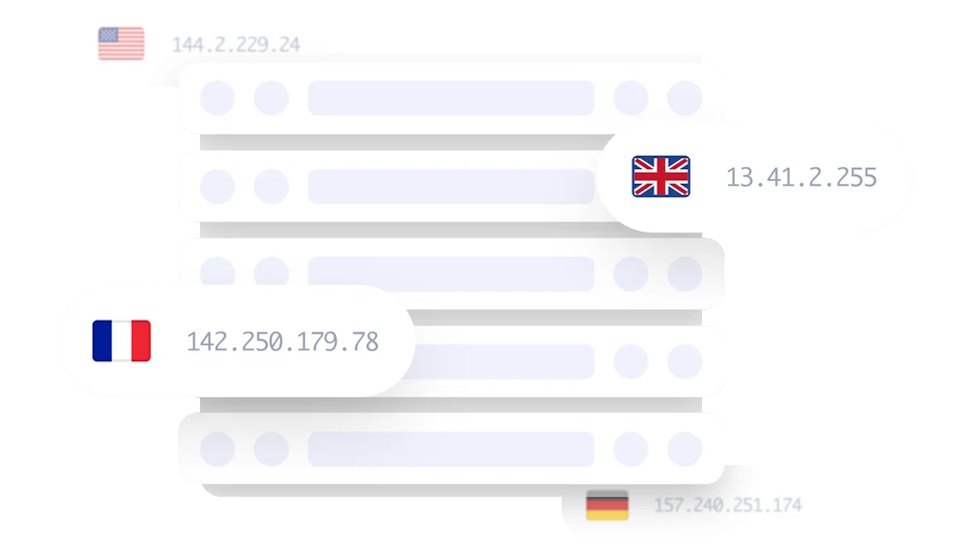
Features
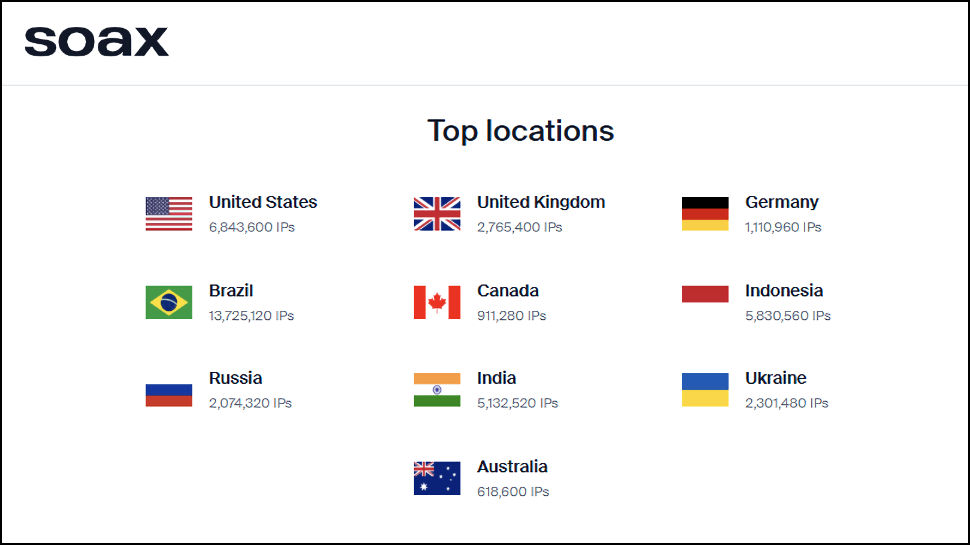
SOAX stands out immediately for its vast proxy pool. There’s an outstanding 155M+ residential IPs (even a giant like Oxylabs ‘only’ claims 100m+), 33m+ mobile, 2.6m+ USA ISP and a mix of shared and dedicated datacenter IPs. HTTP, HTTPS and SOCKS5 proxies are on offer.
You get plenty of control over every area of the service. You’re able to target by 195 countries (see the full list here), city, even ASN/ ISP, allowing you to unblock even the most regional of restrictions.
Residential proxies rotate by default, with standard refresh rates ranging from 1 to 60 minutes, and the option to enter a custom duration if you need something different. You can also opt to use sticky IPs if you prefer, avoiding automatic rotation, or simply opt for a new IP with every request.
There are some restrictions, too. Requests are limited to 1,000 per second for a single plan, and, by default, you’re not able to access websites through ports other than 80 or 443. (SOAX may allow others, depending on your use case.)
The proxy business has its shady side, and that’s bad news for everyone: proxy misuse means poor IP reputations and regular IP blocks. SOAX has a strong focus on trust, and uses various tactics to avoid abuse. KYC (know your customer) checks verify a user’s identity for most plans; usage is restricted to ‘pre-approved ethical use case’; platform usage is continuously monitored to spot signs of abuse, and the company says it quickly investigates and blocks anyone breaking the rules.
Performance
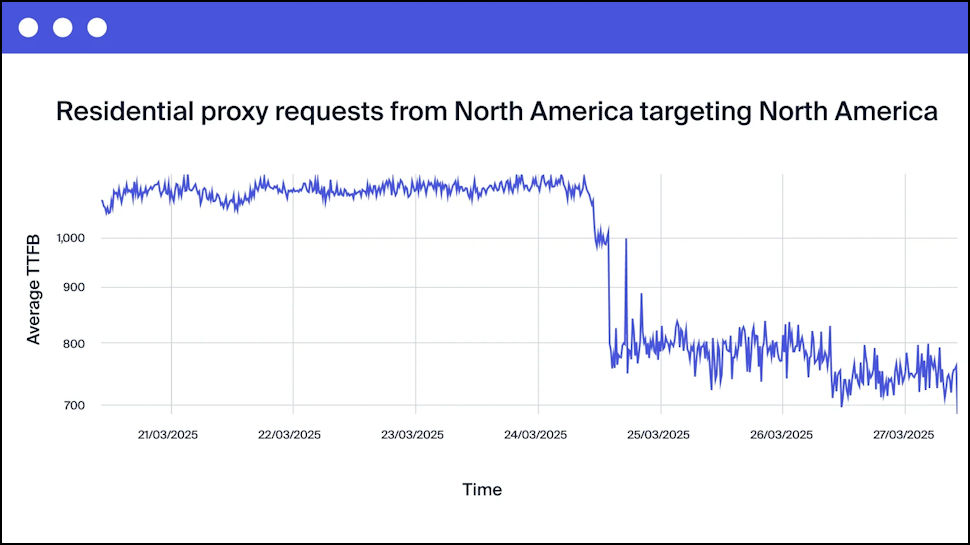
The company has been working hard on performance, and recently announced a major infrastructure upgrade ‘reducing networking hops and streamlining our routing… bringing proxy servers closer to users and target websites in North America…’
SOAX claims this reduces datacenter latency by 64% for North American users targeting websites in the US and Canada. The residential proxy Time To First Byte metric (TTFB) has dropped from 1,370ms to only 760ms, and even international users will see some benefit (European connections to the US saw a 16% improvement in TTFB.)
While that sounds good, we were keen to verify these results with our own tests. We ran some checks from the UK, targeting the UK to get the best possible speeds, and the residential proxy results were very similar to SOAX’s, with the TTFB averaging an excellent 787ms. Speeds you’ll see will vary hugely based on your location, your target and the proxy type, but clearly the SOAX infrastructure can perform very well.
Plans and Pricing
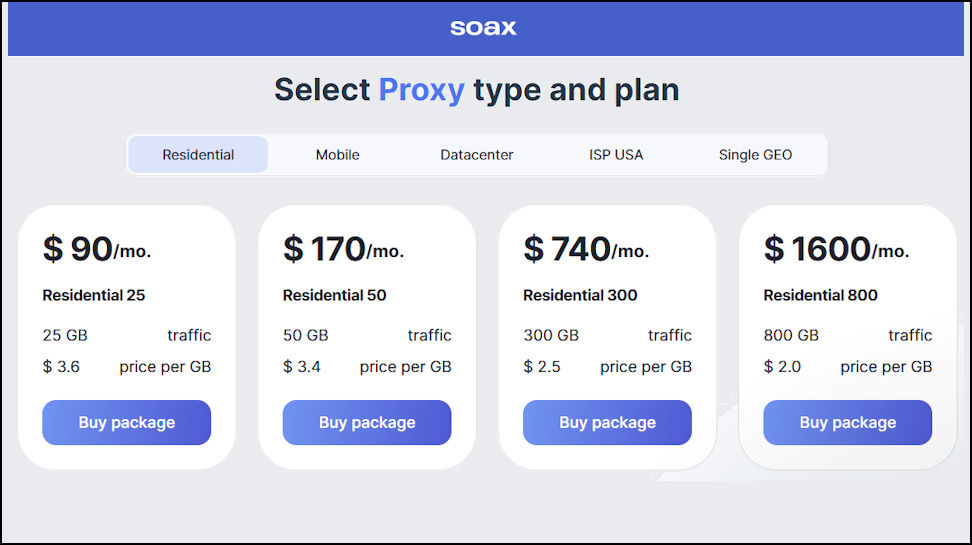
SOAX offers monthly plans, priced by traffic, with – the latest addition – low-cost Pay-As-You-Go options if you don’t want to commit or you’re just looking to test the service.
Residential and mobile proxies start at $90 a month for 25GB, or $3.60 per GB. That drops for $2 per GB on the $1600 a month, 800GB deal, with custom plans available if you need more. That’s good value, and unlike Oxylabs and a few other providers right now, it’s not based on a 50% discount voucher that expires in six months. This is the long-term price.
The USA ISP proxy plans start at $90 for 30GB ($3 per GB), and your Datacenter options start at $49 for 80GB ($0.62 per GB.)
Too much? New Pay-As-You-Go plans have low starting prices, are only a little more expensive per GB, and have minimal commitments. PAYG Residential and mobile proxies are only $4 per GB, for instance, barely 11% more than the basic standard plan, with a minimum data requirement of just 1GB.
You can also opt for a 3-day, 400MB trial for just $1.99. That makes for a low headline price, but if you’d like more time, opting for a Pay As You Go plan could make more sense. You’ll spend at least $4 instead of $1.99, but you’ll get 2.5x as much data, you won’t have to rush through your tests in only 3 days, and – unlike the trials – there’s no risk of the plan renewing for at least $90 if you forget to cancel.
Refunds are available, but only in very limited cases; SOAX hasn’t lived up to its SLA, for instance, or you’ve bought a package accidentally and never used it. But if you’ve bought a trial package, used some data or paid by crypto, there’s no refund option.
SOAX could give users a little more control in some areas. Billing is always per GB, for instance, with no per IP option. It’s monthly billing only But, overall there’s a lot to like about SOAX pricing. Standard plans have reasonable starting fees, the per GB cost is a fraction of the competition, and PAYG options give you flexibility without any real price penalty. If cutting costs is high on your priority list then SOAX is a must-see.
Signing up
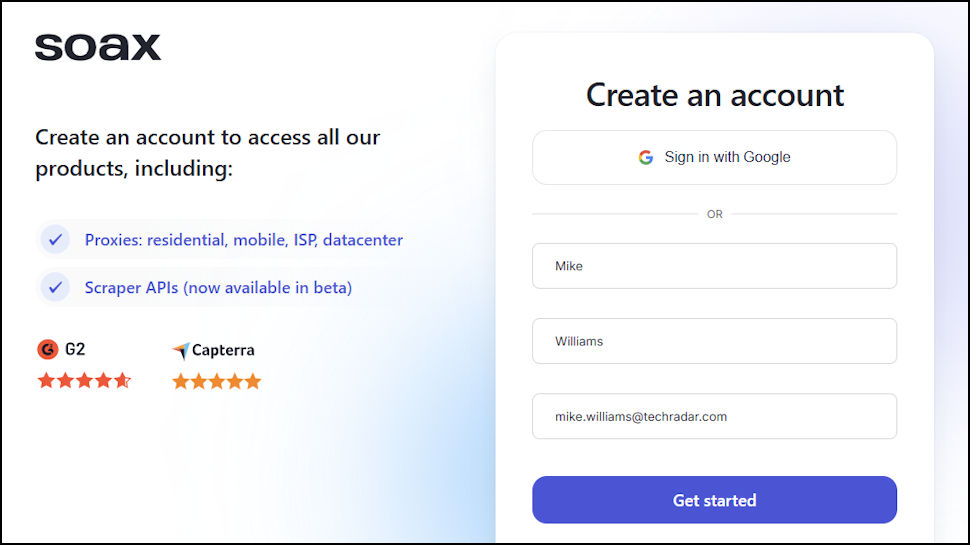
Signing up with SOAX is easy. There are no lengthy identity checks, no need to provide documents just yet (KYC checks don’t happen until you sign up for one of the full paid plans); enter your name and verify your email address (or just sign up with Google) and you’re in.
The SOAX dashboard opens at the Pricing page. Choose your preferred plan or trial, hand over your cash (we were able to pay by card only, but crypto and other options are available once you verify your identity), and the subscription is immediately added to your account.
The website refreshed at the main dashboard screen, a good-looking panel with a whole host of configuration options and status details. There’s a lot to explore, but SOAX does its best to help, with an initial nine-step walkthrough highlighting the key dashboard areas and what they do.
If, like us, you tend to rush through website onboarding, or sometimes skip it altogether, that’s okay too. The SOAX support chatbot is only click away, and although it’s not smart enough to solve any complex problems, we found it handy for explaining the ‘where do I find…?’ startup basics.
Getting started with SOAX
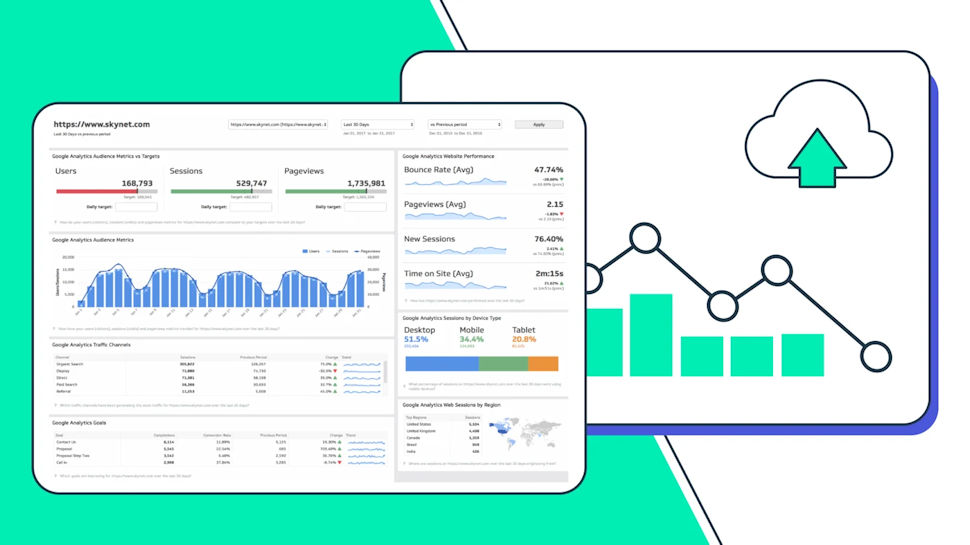
Setup complete, it’s back to the dashboard to explore SOAX properly. This all starts with authorization, where you can opt to authenticate with a username and password or via IP whitelisting. We tried both, and in each case had to then specify our preferred IP rotation time, city, state or IP targeting, and assign them to specific ports.
That was enough for our first few tests, but if our needs were more complex, we could add more filters to target different locations or use other IP location schemes.
When you’re done, you can download your proxies in TXT, CSV and HTML formats. A handy Online Proxy Checker allows you to test up to 50 of these, report on their status and response times, and export only the working proxies. (You don’t have to be a SOAX customer to try this, it works with any proxies. Check it out here)
While SOAX offers a lot of proxy configurability and control, it doesn’t have the depth of functionality of the big names. Its proxy API is horribly basic when compared to the likes of Oxylabs, for instance, just a handful of calls to whitelist IPs and get location details. And although Decodo has supporting tools including browser extensions and its X Browser, there’s nothing like that here.
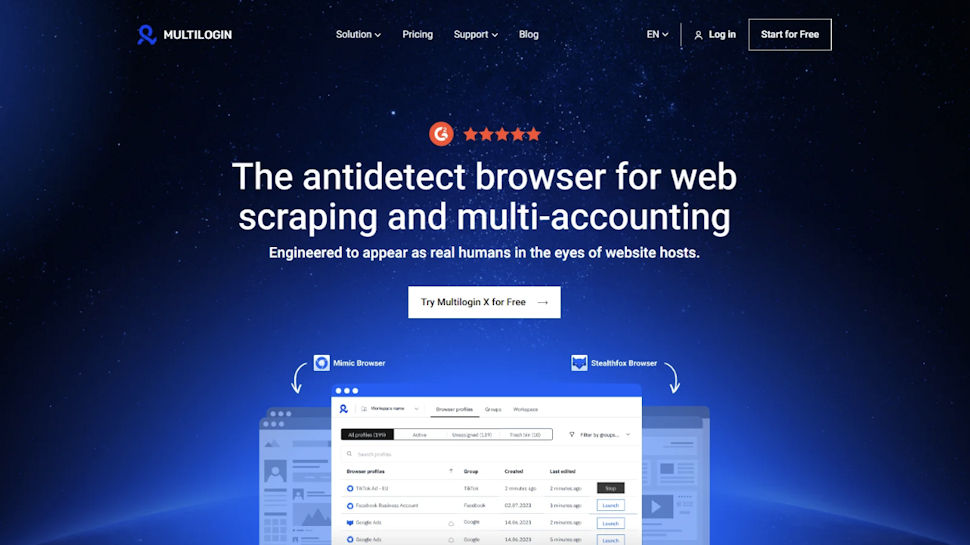
SOAX arguably makes up for this, though, with easy integration for a number of anti-detect browsers. The SOAX Integrations page links to tutorials covering how to get SOAX working with 15 popular tools, including Multilogin, GoLogin, AdsPower, Incognition and more.
Support
SOAX is relatively straightforward to use, but if you run into problems then support is on hand 24/7 via website, live chat and email.
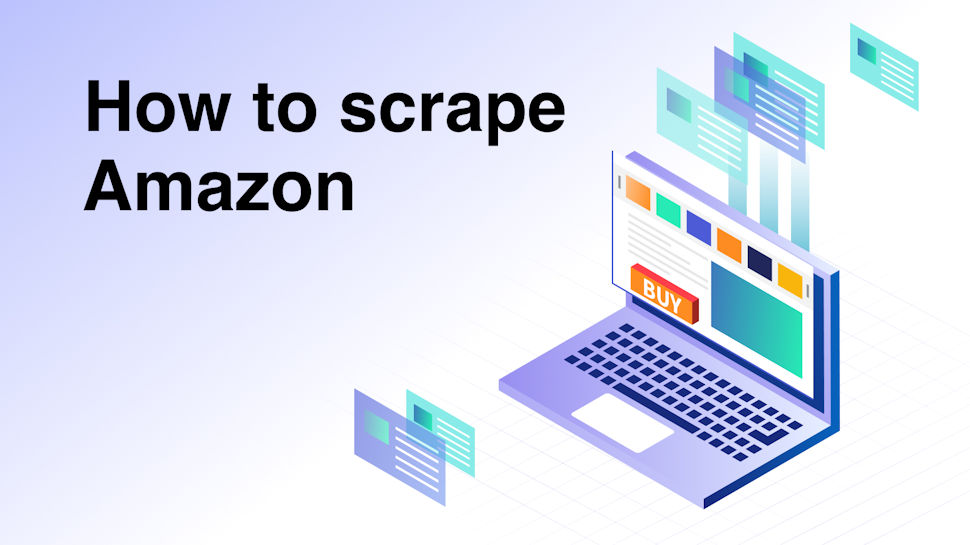
The support site seems strong in some areas, at least initially, with 21 articles explaining the dashboard and its features, and 43 tutorials covering how to use your proxies with assorted operating systems, anti-detect browsers and other apps.
Dig deeper, though, and the reality is a little different. Some articles spend more time explaining basic definitions (what is a datacenter IP?) than offering detailed setup advice. We ran across some clumsy issues, including broken links for some important documents.
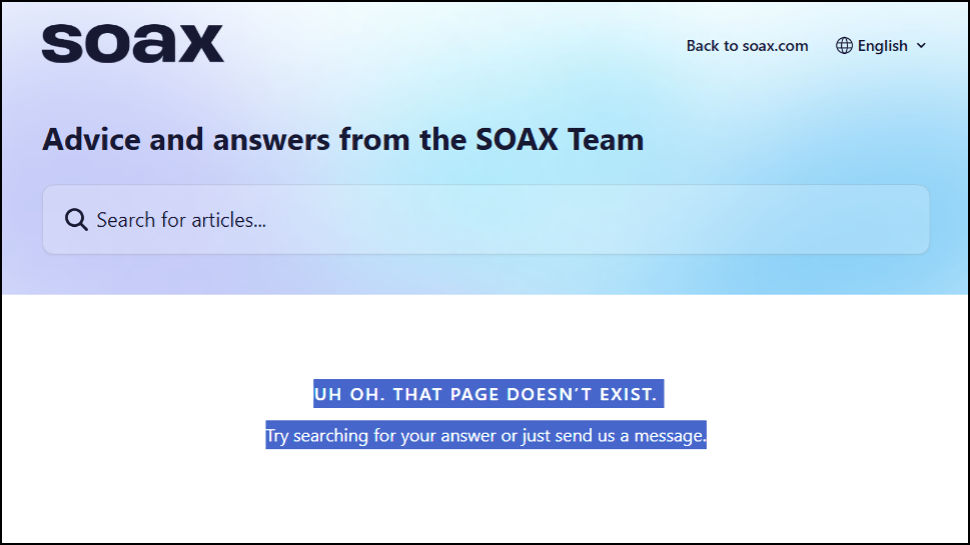
And if you move outside the Dashboard and Software sections, other categories are distinctly short of content. There are only five brief articles in the API section, but instance, and the Troubleshooting section has only three.
Fortunately, if you can’t find what you need on the website, the support team is available 24/7. We asked a couple of questions via live chat and in both cases received a friendly and helpful reply within a very speedy 3-4 minutes, as fast a response time as we see anywhere.
Final Verdict
SOAX is a quality proxy service, but it won’t be right for everyone. Prices can’t compete with budget providers like proxy-cheap.com, for instance. SOAX doesn’t have the rich API of Oxylabs, or the management tools you’ll get with the likes of Decodo (formerly Smartproxy).
But there’s plenty of good news, too. Signing up with SOAX gets you one of the largest pools of residential proxies around. There’s ultra-flexible rotation and targeting options, with helpful 24/7 live chat support to quickly solve any issues.
Better still, although SOAX has some shortcomings, it’s releasing major updates all the time. Just the four weeks prior to this review saw the arrival of lower pricing (including Pay As You Go) and big speed-boosting infrastructure improvements. If you’re looking for a quality mid-market proxy service then SOAX is one of the best around.







Leave a Comment
Your email address will not be published. Required fields are marked *